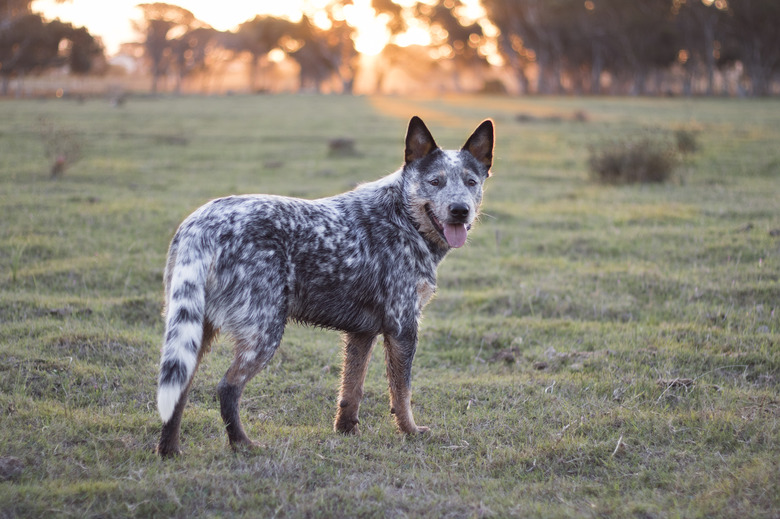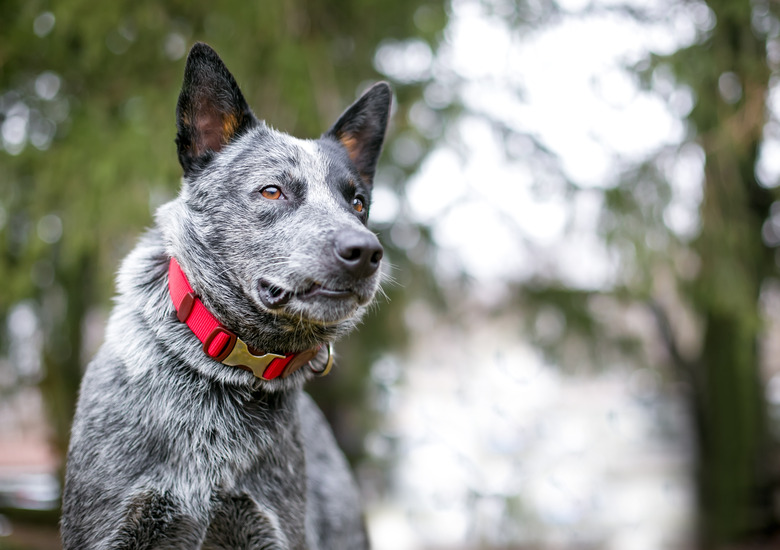How To Keep A Blue Heeler Busy
Australian cattle dogs, known unofficially as blue heelers or Queensland blue heelers, are members of the herding group of dogs, as recognized by the American Kennel Club. Renowned for both their high energy and uncanny intelligence, they love to be active. Investing time and patience in training is necessary for a cattle dog to reach her full potential. In addition to daily walks, hiking, and swimming, there are several organized activities and sports you may consider to satisfy your cattle dog's mental and physical needs.
Blue heeler exercise needs
Blue heeler exercise needs
Australian cattle dogs were bred to work and have a mind of their own. They must be given something to do, or they will make their own decisions which often result in destructive behavior such as chewing, herding, or nipping at the heels of people and other pets in the home. Walking your Australian cattle dog with her by your side is one simple way for your dog to get the physical exercise the breed requires, while building a strong bond and developing trust.
Blue heeler exercise suggestions
Blue heeler exercise suggestions
Like all cattle dog breeds, the blue heeler exercise needs are high. Here are some suggestions for daily activity: Pick up the pace of a regular walk by rollerblading or riding your bicycle with your dog jogging alongside. Or give your dog more of a workout than a regular walk with a backpack containing books or a ballast that weighs between 10 and 20 percent of your dog's weight.
The addition of the backpack has a calming effect on most dogs and gives them a sense of purpose. Trainers regularly use backpacks to help rehabilitate aggressive or over-protective dogs and those with extremely high energy.
Organized sports for your Australian cattle dog
Organized sports for your Australian cattle dog
Consider keeping your Australian cattle dog busy by joining organized sports such as rally obedience, flyball, agility, or herding trials. Nearly every town and city has some kind of dog club and the internet offers many resources. Depending upon your cattle dog's personality, one or more of the available activities will appeal to you both and give her a chance to work her body and mind.
Rally obedience for cattle dog breeds
Rally obedience for cattle dog breeds
A combination of competition obedience and agility, rally obedience was developed in 2000 by Charles Kramer, the original innovator of the American Agility program in 1984. Rally relies on positive training methods and enhances the human/dog bond with its softer approach than traditional competition obedience. You and your dog move through the course in a lighthearted manner following signs and performing instructions for different behaviors that are written on cards. It's all about having fun and interacting with your dog while competing for titles.
Flyball or agility for Australian cattle dogs
Flyball or agility for Australian cattle dogs
Many Australian cattle dogs excel at the sport of flyball. Fast-paced and exciting, flyball is a race between two teams of four dogs in which they race over hurdles to trigger a box that releases a ball that they carry back over the hurdles. It is a fascinating sport to watch as the dogs are so completely focused and single-minded in their mission.
An obstacle course for dogs, agility competition is an entertaining sport for the participants and audience. The course includes seesaws, hoops, tunnels, cat walks, and obstacles through which you and your dog maneuver off-leash. Agility is the perfect sport for Australian cattle dogs as they were bred to perform a series of intricate moves around cattle many times larger than themselves. This predisposition toward being able to execute complex zigzag moves and predilection for turning on a dime is part of their makeup, and the obstacles on the agility course mimic these challenges.
Herding trials meets blue heeler exercise needs
Herding trials meets blue heeler exercise needs
Herding trials are one of the best ways to release the potential of your Australian cattle dog. Herding trials are sponsored through the AKC to preserve and perpetuate the breed's herding instincts. There are three levels of competition in the AKC's program: Herding Tested, Pre-Trial Testing, and Herding Trials. These trials are open to dogs over 9 months of age that are registered with the organization. If your dog is not registered, or not pure bred, there are opportunities to become involved with herding trials through independent dog clubs.
Frisbee and fetch for Australian cattle dogs
Frisbee and fetch for Australian cattle dogs
There are many kinds of activities your dog and you can do right at home on a daily basis. Some Australian cattle dogs are addicted to fetch, returning the ball directly to your hands like a flyball box. Others love jumping up in the air after Frisbees. Both of these games are exhilarating and rewarding for both you and your dog. It's important to create a psychological challenge in addition to a physical one. Make your dog sit or lie down in between throws to keep it interesting.
Reinforce training with cattle dog breeds
Reinforce training with cattle dog breeds
Spend quality time with your blue heeler while keeping her busy by having regular, short training sessions throughout the day of commands she already knows. Practice of commands such as sit, stay, down, and the recall, reinforce positive behavior and contribute to an overall well-behaved dog. Australian cattle dogs will take over if they can, so kind consistent training with their pack leader is a positive interactive activity to practice on a regular basis.
Most sports and other strenuous activities are good for healthy, fit, and energetic dogs. Always check with your veterinary professional before undertaking any new activities with your pet.

